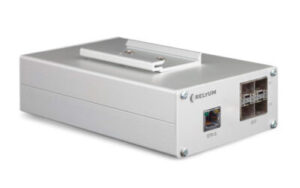- Home
- Technical Products
Enterprise Cloud IT Solutions
Test Measurement
Industrial Measurement
- Solutions
Enterprise Cloud IT Solutions
Test Measurement
- Resource Center
- About Us
 EN
EN
RELY-RB
Time-Aware Redbox Switch
Critical systems require time-aware, high-availability networks. In addition, the complexity of modern network infrastructures in these venues overcomes the traditional concept of a "network management" appliance.RELY-RB is a new concept in intelligent appliances that integrates field-proven advanced technologies for packetless redundant Ethernet, sub-microsecond synchronization and network security. The device is capable of merging an entire LAN with a redundant network to interconnect PRP and HSR networks and extend HSR rings via QuadBox operation.

communication interface
The RELY-RB series consists of three different models based on the number and type of communication interfaces available in the device.
RELY-RB
- 1 10/100/1000Base-TX Ethernet copper port (console/service/security)
- 4 SFP Fixed Frames for 10/100/1000Base-TX Ethernet Copper or 100Base-FX/1000-Base-X Optical Fiber
RELY-RB + (discontinued)
- 1 10/100/1000Base-TX Ethernet copper port (console/service/security)
- 6 copper 10/100/1000Base-TX Ethernet ports
RELY-RB + 2 (discontinued)
- 1 10/100/1000Base-TX Ethernet copper port (console/service/security)
- 6 copper 10/100/1000Base-TX Ethernet ports
- 2 SFP Fixed Frames for 10/100/1000Base-TX Ethernet Copper or 100Base-FX/1000-Base-X Optical Fiber
Communication Technology
- Multiple PTP 3-speed Ethernet ports (type and number depending on model)
- Zero packet redundancy mode:
IEC 62439-3 v3 Clause 5 "High Availability Seamless Redundancy (HSR)"
Supported modes: H, N, T, U, HSR-SAN, PRP-HSR, HSR-HSR - IEC 62439-3 v3 Clause 4 "Parallel Redundancy Protocol (PRP)".
Supported modes: Repeat Discard, Repeat Receive, Transparent Receive, PRP-HSR - Optional redundancy mode:
- IEC 62439-2 Clause 5 "Media Redundancy Protocol (MRP)"
- Ethernet IP "Device Level Ring (DLR)"
- RSTP IEEE802.1w
- VLAN Support
- Ethernet-based or IEEE 802.1P traffic prioritization
- Straight-through and store-and-forward switching functions
processing power
- Xilinx Zynq FPGA with embedded dual-core ARM9 processor
- 1GB DDR3 RAM memory
- Linux operating system
safety function
- Optional support for IEC 62351-6 wire-speed encryption
- IEC 62351-9 Secure Infrastructure for Key Switching Facilities
- AES 256, HMAC and RSA hardware engines for software and firmware encryption, authentication and signatures
- Security Activation
- Security of system-level audits (operating systems and applications)
- Integrated anti-tamper, accelerometer and power measurement sensors mitigate advanced security attacks
- Ethernet ports isolated from the switching infrastructure to enable security-oriented services (NAT, firewall, VPN, etc.)
- IEEE 802.1X access control for port-based and MAC-based authentication, MAC port bonding and authentication for login security
- Optional internal mirroring port with deep packet inspection capability
- Optional integrated SIEM agent for IDS and Syslogv5 TLS support for distributed SIEM approach
synchronization
- IEEE 1588-2008 PTPv2
- Operation modes: Transparent Clock, Normal Clock, Boundary Clock
- Profiles: default, power, IEC 61850-9-3, AS
- Optional IRIGb Master/Slave Bridge
- IEEE 1588 stateless transparent clock P2P (peer-to-peer) mode, supports IEEE 1588 PRP/HSR redundant network merging
Rugged equipment
- IEC 61850-3/IEEE 1613
- Fanless design
- Full metal housing
- Redundant power supply: 6VDC to 30VDC (48VDC and 125VDC optional)
- Operating temperature: -40°C to + 70°C
- Storage temperature: -40°C to + 85°C
- Optional mounting: DIN rail
Configuration and Management
SNMPv3, SSH
Web-based HTML5-GUI access/configuration:
Accessible via HTTP(S)
Configuring Profiles and Firmware Updates
Real-time network monitoring
Other interfaces (not available in all models)
- 1 RS485 port
- 2 USB Type A ports
- 1 HDMI output
- 1 alarm output (max. potential-free relay output 250VAC)
- 1 Pulse Per Second (PPS) SMA output
Keeping up with the times and innovating - Explore more potentials of TSN with Hongke
Time Sensitive Networking (TSN) is a new generation of network technology based on the evolution of the standard Ethernet architecture. It takes traditional Ethernet as the network foundation and provides a data link layer protocol specification for deterministic data transmission capability through mechanisms such as clock synchronization, data scheduling, and network configuration. Compared with traditional Ethernet, TSN can provide microsecond-level deterministic services, reduce the complexity of the entire communication network, and realize the convergence of information technology (IT) and operation technology (OT). With its precise clock synchronization, deterministic traffic scheduling, and intelligent and open operation and maintenance management framework, TSN can ensure the high-quality transmission of multiple business traffic in a common network, and it has both performance and cost advantages, and it is the development trend of the future network. This is the future trend of network development.
Currently, TSN technology has a high level of discussion in the automotive, industrial, rail transportation, and aerospace fields. As a non-vendor-bound real-time communication protocol, we believe that TSN technology has a good application prospect.
Welcome to contact us to explore and learn the integration of TSN technology with various industries, and actively promote more applications on the ground to jointly build a new world of intelligent interconnection.

